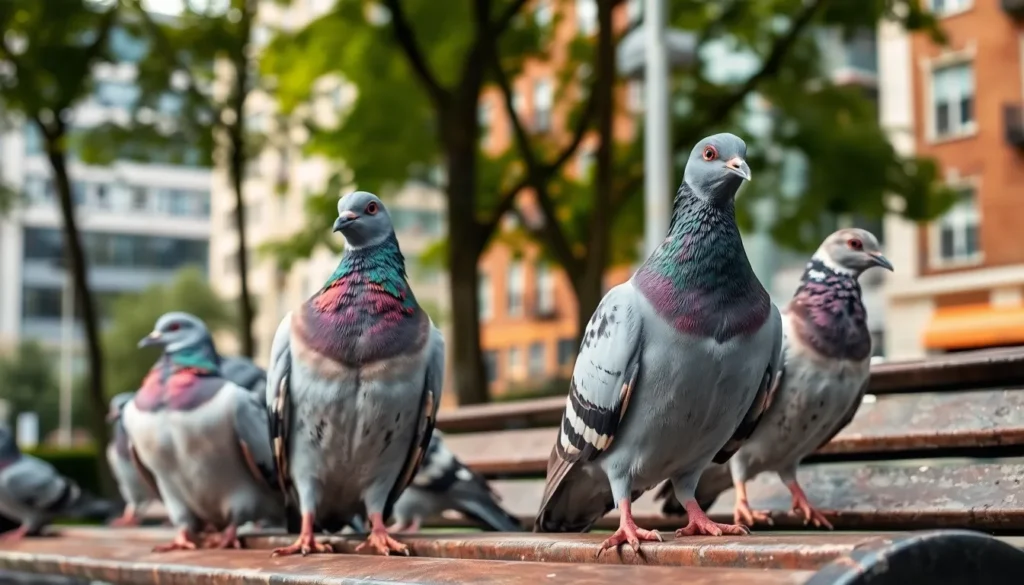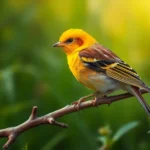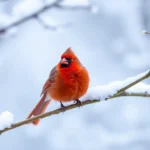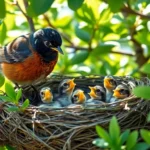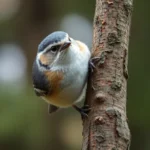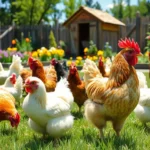We often overlook pigeons as ordinary city dwellers, but these remarkable birds deserve far more recognition than they receive. Found on every continent except Antarctica, pigeons have mastered urban living like no other species, adapting brilliantly to our concrete jungles while maintaining fascinating behaviors that’ll surprise you.
These intelligent creatures aren’t just random street birds – they’re incredible navigators with documented abilities to recognize themselves in mirrors and distinguish between different art styles. We’ve discovered that pigeons possess remarkable memory skills and can even be trained to perform complex tasks that rival those of much larger animals.
Whether you’re curious about their unique breeding habits, their historical significance as messenger birds, or simply want to understand why they thrive in cities worldwide, we’ll explore everything you need to know about these underestimated urban survivors.
Understanding the Pigeon Bird: An Overview
Pigeon birds belong to the Columbidae family, which encompasses over 340 species worldwide. These remarkable creatures display extraordinary diversity in size, coloration, and habitat preferences across six continents. Most urban dwellers encounter the common rock dove (Columba livia), though this species represents just one branch of the extensive pigeon family tree.
Physical characteristics of pigeons vary significantly among species, ranging from the tiny diamond dove weighing 23 grams to the massive crowned pigeons reaching 2.5 kilograms. Their body structure features compact builds, small heads, and distinctive cooing vocalizations that serve multiple communication purposes. Feather patterns span from solid grays and browns to iridescent greens, purples, and elaborate crested displays in ornamental species.
Habitat adaptation demonstrates pigeons’ remarkable evolutionary success, with different species thriving in environments from dense tropical rainforests to arid deserts. Urban pigeons colonize cities by utilizing building ledges as cliff substitutes, while wood pigeons prefer suburban areas with abundant trees. Ground-dwelling species like mourning doves favor open grasslands and agricultural regions.
| Pigeon Species Category | Typical Weight Range | Primary Habitat |
|---|---|---|
| Urban rock doves | 300-500 grams | Cities, buildings |
| Wood pigeons | 450-700 grams | Forests, suburbs |
| Ground doves | 20-60 grams | Grasslands, scrubland |
| Crowned pigeons | 1.5-2.5 kilograms | Tropical forests |
Behavioral patterns reveal sophisticated social structures within pigeon communities. Flocking behavior provides protection from predators while facilitating information sharing about food sources and nesting sites. Mating rituals involve elaborate courtship displays where males puff their chests, bow repeatedly, and emit distinctive cooing sequences to attract females.
Dietary flexibility contributes significantly to pigeons’ widespread distribution success. Seed consumption forms their primary nutrition source, though urban populations adapt by consuming human food scraps, bread crumbs, and processed grains. Specialized crop organs allow pigeons to store and process large quantities of seeds efficiently.
Reproductive capabilities enable rapid population growth under favorable conditions. Pigeons breed year-round in temperate climates, producing 2-3 broods annually with clutches containing 1-2 eggs. Both parents participate in incubation duties lasting 17-19 days and feeding responsibilities for 25-30 days post-hatching.
Physical Characteristics of Pigeon Birds
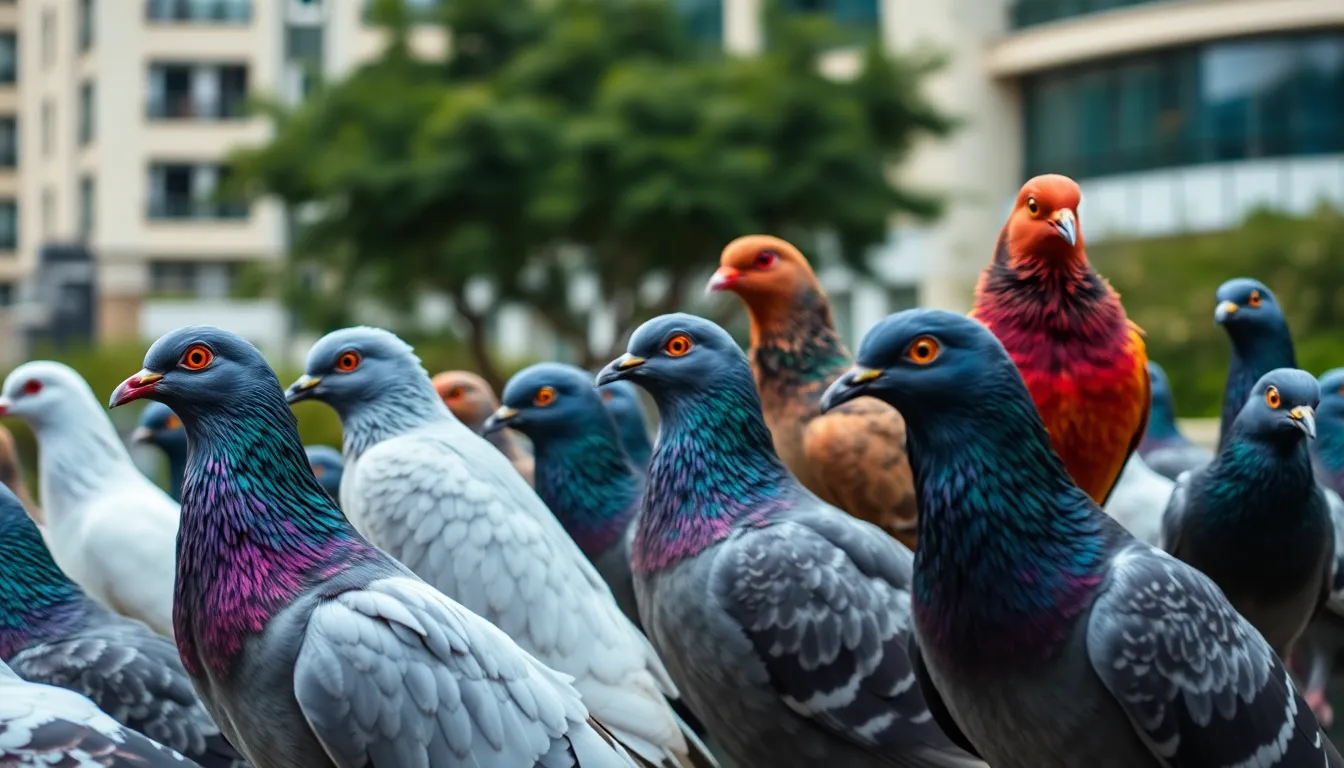
Pigeon birds display remarkable diversity in their physical appearance across the 340+ species within the Columbidae family. These adaptable creatures showcase variations that range from compact city dwellers to elaborate forest species with distinctive anatomical features.
Size and Weight Variations
Pigeon species exhibit important size differences that reflect their diverse evolutionary adaptations. The smallest members like the diamond dove weigh just 1.1 ounces (30 grams) and measure 7.5 inches (19 cm) in length. Large species such as the Victoria crowned pigeon reach weights up to 4.4 pounds (2 kg) with wingspans extending 39 inches (99 cm).
Urban pigeon populations typically weigh between 10-18 ounces (300-500 grams) and measure 12-14 inches (32-37 cm) from beak to tail. Rock doves, the most common city pigeons, maintain consistent proportions with males averaging slightly larger than females. Weight variations often correlate with habitat availability, with well-fed urban populations showing higher average weights than rural counterparts.
Distinctive Plumage Patterns
Coloration patterns in pigeon birds demonstrate extensive genetic diversity within individual populations. Common urban pigeons display three primary color morphs: blue-gray with dark bars, checkered patterns with alternating light and dark patches, and reddish-brown variations called “red bars.”
Iridescent neck feathers create stunning displays of green and purple hues that shift with light angles and viewing positions. These metallic colors result from microscopic structures in the feather barbules that reflect exact wavelengths. Wild species like the Nicobar pigeon feature dramatic metallic green and copper plumage, while mourning doves maintain subtle brown and gray tones for camouflage.
Head markings vary significantly between species, with some displaying prominent white patches around the eyes or distinctive colored crowns. Tail patterns range from solid colors to banded designs that serve identification purposes during flight displays.
Unique Anatomical Features
Pigeon anatomy includes specialized adaptations that support their remarkable navigation and survival capabilities. Their eyes contain specialized cells called “cryptochromes” that detect magnetic fields, contributing to their legendary homing abilities across distances exceeding 1,000 miles (1,600 km).
Crop milk production sets pigeons apart from most bird species, as both males and females secrete this protein-rich substance to feed their young. The crop, located in the esophagus, enlarges during breeding season to accommodate this unique feeding adaptation.
Feet structure varies between species based on perching requirements, with urban pigeons developing strong, curved talons for gripping concrete and metal surfaces. Wing shapes reflect flight patterns, with city pigeons possessing broad, powerful wings for quick takeoffs and maneuvering between buildings.
Beak morphology adapts to dietary preferences, ranging from small seed-cracking beaks in ground-feeding species to larger, more robust bills in fruit-eating varieties. Nostril positioning and size correlate with respiratory efficiency during extended flight periods.
Pigeon Bird Species Around the World
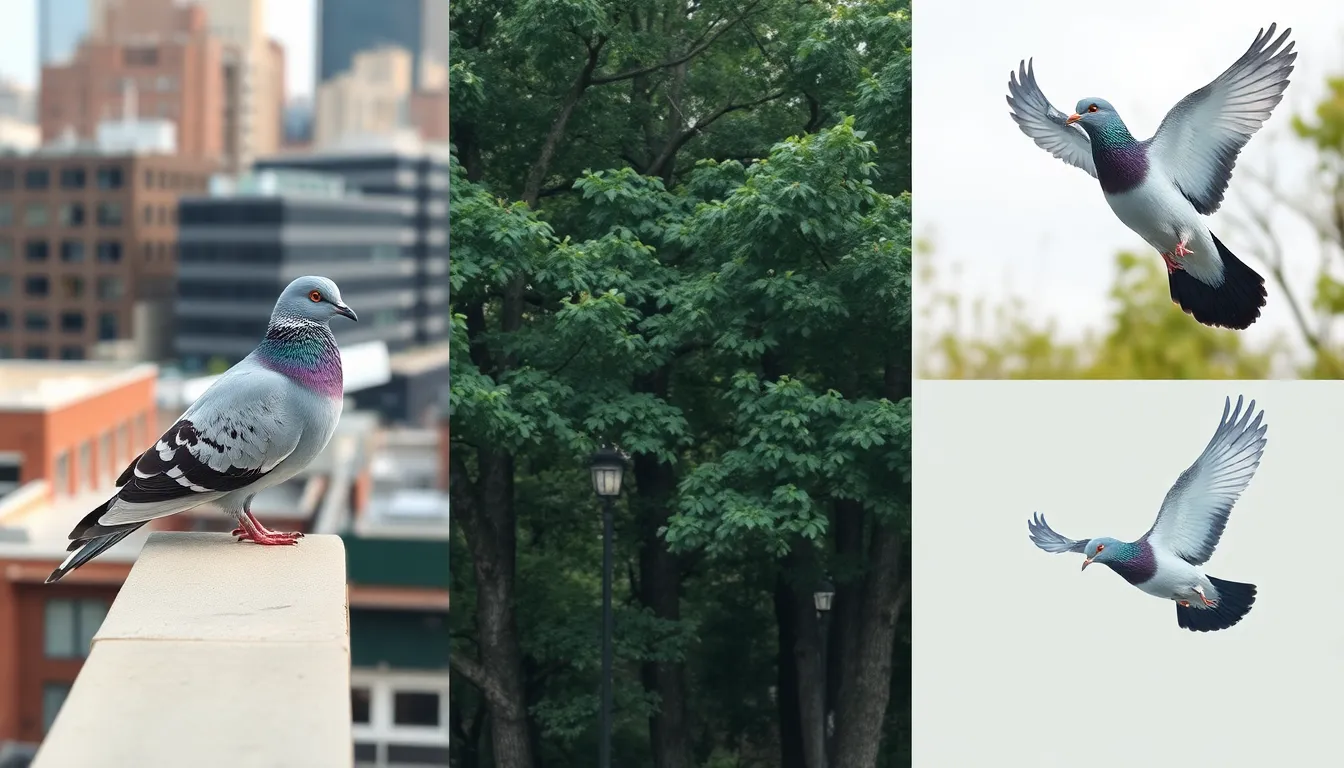
Pigeon bird species demonstrate remarkable diversity across global habitats, from bustling city centers to remote wilderness areas. We explore three distinct species that showcase the evolutionary adaptations and historical significance within the Columbidae family.
Rock Dove: The Common Urban Pigeon
Rock doves (Columba livia) represent the most recognizable pigeon bird species in metropolitan environments worldwide. These adaptable birds measure 32-37 centimeters in length and weigh between 300-500 grams, making them medium-sized members of their family.
Original rock dove populations inhabited coastal cliffs and rocky outcrops across Europe, North Africa, and western Asia. Urban environments provide similar nesting opportunities through building ledges, bridges, and architectural features that mimic natural cliff faces. City-dwelling rock doves display remarkable behavioral flexibility, adjusting their feeding schedules to match human activity patterns.
Physical characteristics of urban rock doves include blue-gray plumage with distinctive dark wing bars and iridescent green-purple neck feathers. Color variations range from pure white to deep russet-brown due to centuries of selective breeding and genetic mixing. These variations create the diverse appearance patterns we observe in city pigeon populations today.
Wood Pigeon: The Forest Dweller
Wood pigeons (Columba palumbus) inhabit deciduous and mixed woodlands throughout Europe and western Asia. These larger pigeon bird species measure 40-42 centimeters in length and weigh 450-570 grams, distinguishing them from their urban cousins through size and habitat preferences.
Distinctive white neck patches and wing markings identify wood pigeons during flight displays and territorial behaviors. Their powerful wing beats produce characteristic whistling sounds that carry through forest canopies during courtship seasons. Wood pigeons demonstrate strong seasonal migration patterns, traveling between breeding and wintering grounds across continental distances.
Diet preferences include acorns, beechnuts, seeds, and agricultural crops like oilseed rape and cereals. Wood pigeons consume up to 100 grams of food daily during peak feeding periods, making them important ecological players in seed dispersal networks. Forest habitats provide essential nesting sites in dense canopy areas where these birds construct platform nests using twigs and branches.
Passenger Pigeon: A Tragic History
Passenger pigeons (Ectopistes migratorius) once represented the most abundant bird species in North America, with populations estimated at 3-5 billion individuals during the early 1800s. These remarkable pigeon bird species measured 39-41 centimeters in length and exhibited distinctive long, pointed tails and streamlined bodies adapted for efficient long-distance flight.
Massive flocks darkened skies for hours during migration periods, creating natural phenomena documented by early American settlers and naturalists. Individual flocks contained millions of birds stretching across landscapes for kilometers, demonstrating unprecedented aggregation behaviors among avian species. Passenger pigeons nested in dense colonies covering thousands of hectares in mature deciduous forests.
Commercial hunting operations eliminated entire populations through systematic harvesting methods between 1870-1890. Market hunters used nets, firearms, and targeted breeding colonies to capture millions of birds for urban food markets. Martha, the last known passenger pigeon, died at Cincinnati Zoo on September 1, 1914, marking the complete extinction of this once-dominant species.
Conservation lessons from passenger pigeon extinction emphasize the vulnerability of even abundant wildlife populations to human exploitation. Modern wildlife management practices incorporate population monitoring and sustainable harvest regulations to prevent similar ecological disasters across other pigeon bird species globally.
Pigeon Bird Behavior and Intelligence
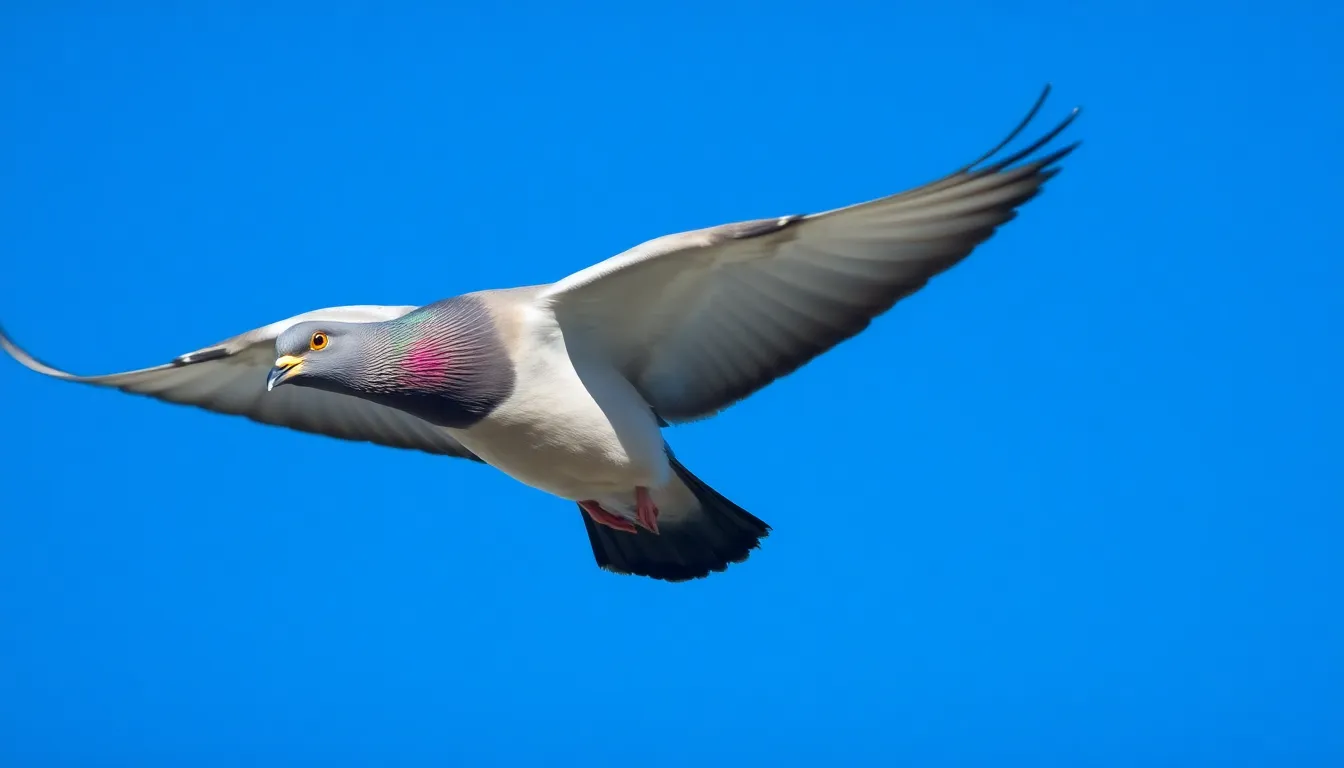
Pigeons display cognitive abilities that rival those of primates and demonstrate remarkable behavioral adaptations that enable their survival across diverse environments. Research conducted at universities worldwide has revealed that these birds possess sophisticated mental capabilities previously underestimated by scientists.
Navigation and Homing Abilities
Pigeon navigation systems operate through multiple sensory mechanisms that create an internal compass more accurate than most GPS devices. Magnetoreceptors located in their beaks detect Earth’s magnetic field variations and provide directional guidance during flight. Cryptochromes in pigeon eyes allow them to visualize magnetic fields as overlays on their visual field.
Racing pigeons consistently return to their home lofts from distances exceeding 1,000 miles with 90% accuracy rates. These birds memorize visual landmarks such as highways, rivers, and building structures to create mental maps of their territories. Infrasonic hearing capabilities enable pigeons to detect low-frequency sounds from ocean waves and atmospheric disturbances up to 350 miles away.
Trained military pigeons during Industry War II achieved delivery success rates of 95% across enemy territory. Experiments at Oxford University demonstrated that pigeons can navigate using polarized light patterns invisible to human eyes. Urban pigeons adapt their navigation strategies by incorporating subway systems and traffic patterns into their route planning.
Social Structure and Communication
Pigeon flocks operate within hierarchical systems where dominant birds control feeding areas and prime nesting locations. Alpha males establish territories through aggressive displays including wing slapping, tail spreading, and cooing vocalizations that reach 60 decibels. Subordinate pigeons recognize social rankings and defer to higher-status individuals during resource competition.
Communication among pigeons involves 15 distinct vocalizations including coos, grunts, and alarm calls that convey exact messages. Mate selection rituals feature elaborate courtship dances where males bow, spin, and puff their chest feathers while producing rhythmic cooing sequences. Pigeon pairs maintain monogamous relationships for entire breeding seasons and share parenting responsibilities equally.
Flock coordination during flight relies on visual cues and rapid decision-making processes that occur within milliseconds. Lead pigeons initiate direction changes that propagate through entire flocks containing hundreds of individuals. Roosting behaviors follow established patterns where familiar birds cluster together while maintaining optimal spacing for warmth and safety.
Problem-Solving Skills
Laboratory studies reveal that pigeons solve complex discrimination tasks with accuracy rates matching those of primates in controlled environments. These birds distinguish between abstract concepts such as “same” versus “different” when presented with geometric shapes and color patterns. Operant conditioning experiments demonstrate that pigeons learn multi-step sequences and remember answers for periods exceeding six months.
Pigeons recognize themselves in mirrors and pass self-awareness tests that many mammals fail to complete successfully. Urban pigeons develop tool-use behaviors such as manipulating objects to access food sources and opening containers through trial-and-error learning. Categorization abilities allow pigeons to sort photographs into groups based on content including people, cars, trees, and water.
Medical research programs train pigeons to identify cancerous tissue in microscopic images with 85% accuracy after receiving visual discrimination training. These birds process visual information faster than humans and detect subtle pattern variations that trained technicians often miss. Mathematical concepts including quantity estimation up to seven items demonstrate abstract reasoning capabilities previously attributed only to higher mammals.
Habitat and Distribution of Pigeon Birds

Pigeon birds occupy diverse environments across six continents, demonstrating remarkable adaptability that spans from bustling city centers to remote wilderness areas. Their global distribution encompasses approximately 120 countries, with populations thriving in environments ranging from sea level to elevations exceeding 4,000 meters.
Urban Environments
Cities provide pigeon birds with abundant nesting sites and food sources, creating ideal conditions for population growth. Skyscrapers, bridges, and building ledges mimic the natural cliff faces where rock doves originally nested, offering protection from predators and weather extremes.
Urban pigeon populations reach densities of 2,000 to 10,000 individuals per square kilometer in major metropolitan areas like New York, London, and Paris. These birds capitalize on human food waste, consuming crumbs, discarded bread, and spilled grains from outdoor dining areas and markets.
Building structures create microclimates that extend breeding seasons, allowing urban pigeons to produce up to six broods annually compared to two broods in natural settings. Heated buildings and underground spaces provide winter shelter, enabling year-round survival in climates where wild populations struggle.
Transportation hubs, shopping centers, and parks serve as primary gathering locations where pigeon flocks congregate in groups of 50 to 500 birds. The constant human activity in these areas creates predictable feeding opportunities that support large populations.
Natural Habitats
Coastal cliffs represent the ancestral nesting environment for rock doves, with colonies establishing territories along rocky shorelines and inland escarpments. These vertical stone faces provide crevices and ledges that accommodate individual pairs while offering protection from ground predators.
Forest environments support wood pigeons and other Columbidae species that prefer tree canopies and woodland clearings. Deciduous and mixed forests across Europe, Asia, and North America host populations that feed on seeds, berries, and young shoots from native vegetation.
Agricultural landscapes attract pigeon birds to grain fields, where they consume wheat, barley, corn, and rice during planting and harvest seasons. Farmland provides open foraging areas combined with nearby trees or structures for roosting and nesting.
Desert regions house specialized pigeon species like the mourning dove, which adapts to arid conditions through efficient water conservation and heat tolerance. These birds locate water sources within 10-kilometer ranges and time their activities around temperature fluctuations.
Tropical rainforests contain the highest diversity of pigeon species, including fruit doves and imperial pigeons that inhabit canopy levels between 20 and 40 meters above ground. These environments support specialized species that feed exclusively on native fruits and play crucial roles in seed dispersal across forest ecosystems.
Diet and Feeding Habits of Pigeon Birds
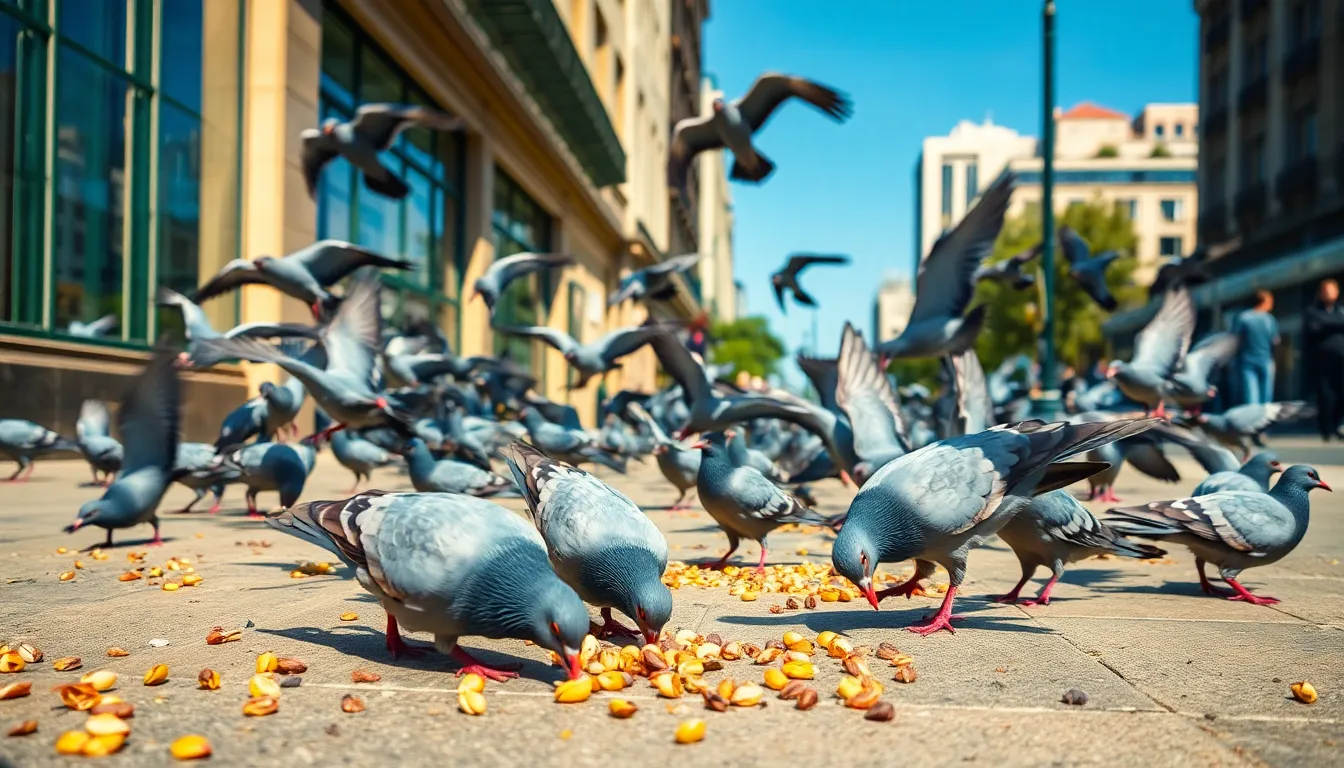
Pigeon birds demonstrate remarkable dietary flexibility that contributes significantly to their global success across diverse environments. These adaptable creatures primarily consume seeds, grains, fruits, and plant materials while occasionally supplementing their diet with insects and small invertebrates.
Primary Food Sources
Seeds form the cornerstone of most pigeon species’ nutritional intake, with urban populations consuming approximately 30-45 grams daily. Common dietary staples include:
- Cereal grains like wheat, corn, barley, and oats
- Tree seeds from maple, pine, and oak species
- Weed seeds including dandelion, chickweed, and clover
- Fruit fragments from berries, cherries, and urban ornamental plants
- Bread crumbs and processed food scraps in metropolitan areas
| Food Type | Daily Consumption | Nutritional Value |
|---|---|---|
| Seeds/Grains | 25-35 grams | High carbohydrates, moderate protein |
| Fruits | 5-10 grams | Vitamins, natural sugars |
| Insects | 2-5 grams | High protein content |
| Human food waste | 10-15 grams | Variable nutritional quality |
Feeding Behaviors and Patterns
Ground foraging represents the predominant feeding method among pigeon species, with birds using their beaks to probe and pick food items from surfaces. Urban pigeons concentrate their feeding activities during morning hours between 6-9 AM and afternoon periods from 3-5 PM when human activity provides abundant food opportunities.
Flocking behavior enhances feeding efficiency through collective foraging strategies. Groups of 20-50 individuals often coordinate their movements to exploit concentrated food sources like scattered grain or dropped food items. Dominant birds within these flocks secure premium feeding positions while subordinate members forage around the periphery.
Crop Function and Digestion
The specialized crop organ distinguishes pigeons from many other bird species by enabling food storage and preliminary digestion. This expandable chamber allows adults to collect substantial quantities of food quickly before retreating to safer locations for processing. Parent birds produce crop milk within this organ to nourish their young squabs with a protein-rich secretion containing 60% water, 13% protein, and 7% fat.
Gizzard function complements crop storage by mechanically grinding consumed materials using small stones and grit that pigeons deliberately ingest. This two-stage digestive system enables efficient processing of hard seeds and grains that form their dietary foundation.
Seasonal and Regional Variations
Agricultural landscapes provide seasonal abundance during harvest periods when scattered grains become readily available across farmland areas. Spring months offer increased insect protein sources that support breeding activities and chick development nutritional requirements.
Coastal pigeon populations supplement traditional diets with marine algae, small mollusks, and beach-deposited organic matter. Desert-dwelling species adapt their feeding schedules to cooler morning and evening temperatures while seeking moisture-rich plant materials to meet hydration needs.
Urban environments create year-round feeding opportunities through consistent human food waste availability, enabling extended breeding seasons and higher population densities compared to natural habitats.
Reproduction and Life Cycle
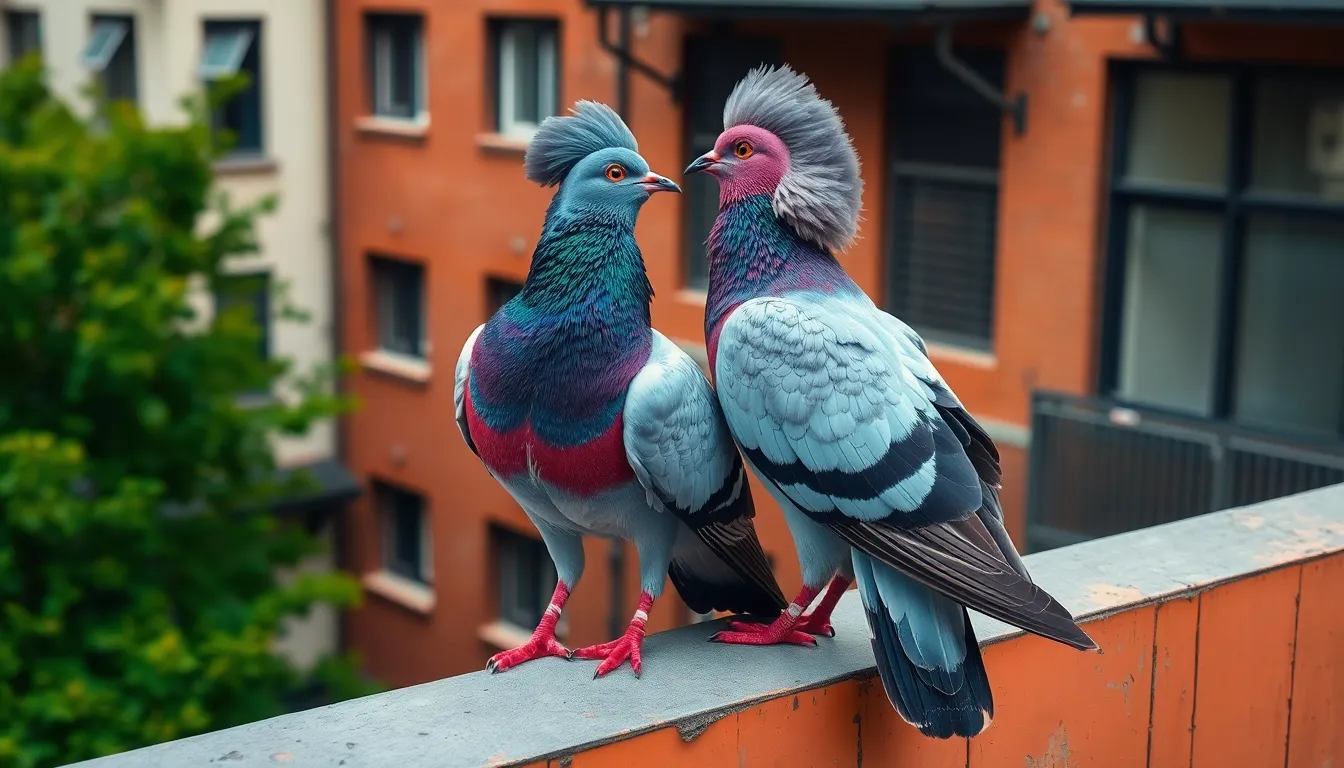
Pigeon reproduction demonstrates remarkable efficiency and adaptability across diverse environments. We observe breeding cycles that can occur multiple times throughout the year, contributing to their rapid population growth and global distribution success.
Mating Rituals
Complex courtship displays characterize pigeon mating behaviors, involving multiple stages of ritualized interactions. Males perform elaborate bowing ceremonies while cooing softly to attract potential mates, puffing their neck feathers and strutting in circular patterns around females. We document distinctive tail fanning displays where males spread their tail feathers wide, creating impressive visual presentations that showcase their fitness and genetic quality.
Pair bonding occurs through mutual preening sessions and synchronized feeding behaviors that strengthen relationships between mates. Pigeons engage in billing rituals where partners touch beaks and share regurgitated food, establishing trust and compatibility for long term partnerships. Monogamous relationships typically last for entire breeding seasons, with some pairs maintaining bonds across multiple reproductive cycles that can span several years.
Nesting Behaviors
Strategic nest placement reflects pigeon adaptability to both urban and natural environments. We find nests constructed on building ledges, fire escapes, bridge supports, and window sills in metropolitan areas, while wild populations select cliff faces, tree branches, and rocky outcroppings. Construction involves collecting twigs, leaves, debris, and manufactured materials like paper and plastic scraps that create stable platforms for egg laying.
Collaborative building efforts involve both male and female partners gathering materials and arranging nest structures. Males typically collect nesting materials while females focus on arrangement and final construction details, creating shallow cup shaped depressions approximately 8 to 10 inches in diameter. Nest reuse occurs frequently throughout breeding seasons, with pairs renovating existing structures rather than building entirely new constructions.
Parental Care
Synchronized incubation duties involve both parents sharing 18 day egg warming responsibilities in alternating shifts. We observe males incubating eggs during daylight hours while females take overnight duties, maintaining consistent temperatures between 103°F and 105°F throughout the development period. Pigeon pairs typically produce two white eggs per clutch, with breeding cycles repeating every 25 to 35 days under favorable conditions.
Crop milk production provides essential nutrition for newly hatched squabs during their first 10 to 14 days of life. Both male and female pigeons secrete this protein rich substance from their crop lining, feeding young through regurgitation that delivers concentrated nutrients directly into squab mouths. Fledgling development progresses rapidly, with young pigeons gaining flight capabilities within 25 to 30 days after hatching, though parental feeding continues for additional weeks as juveniles develop independent foraging skills.
Pigeon Birds and Human Interaction
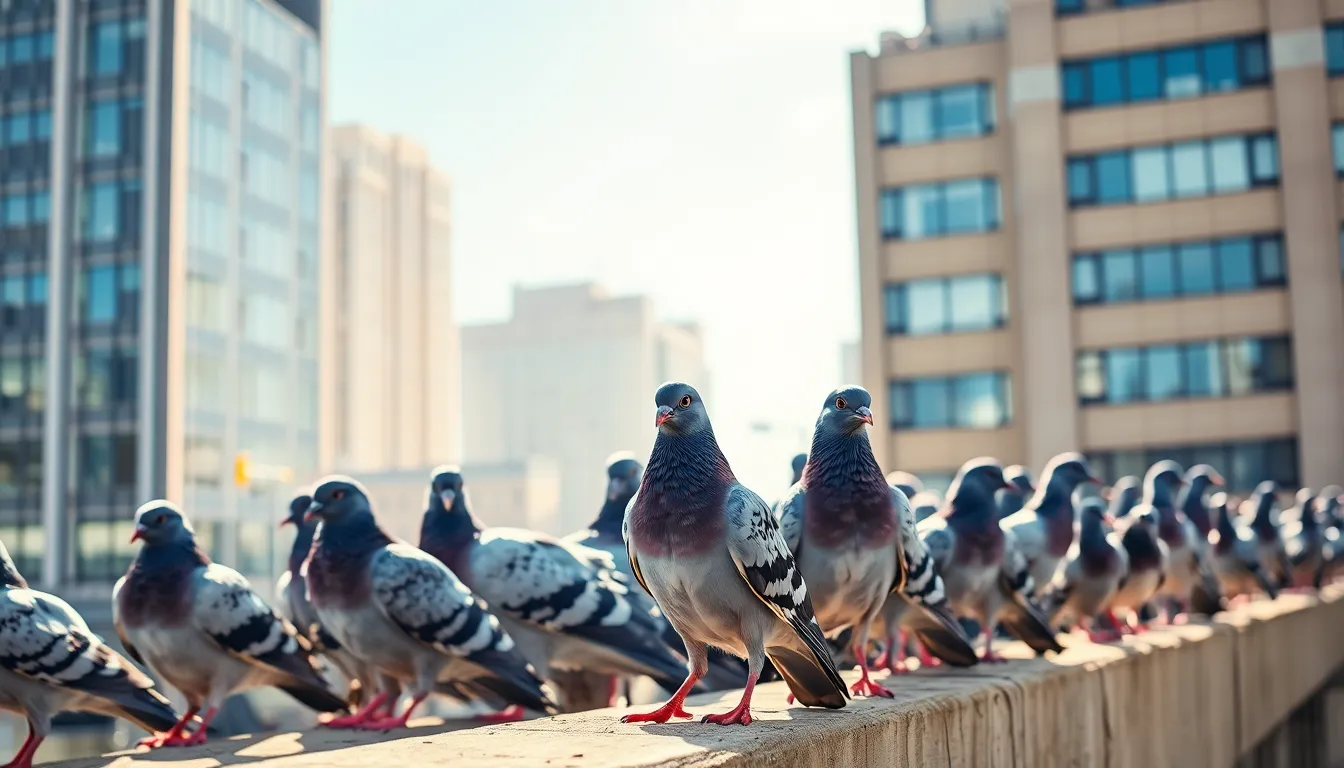
Pigeon birds maintain one of the longest relationships with humans among all wildlife species. These remarkable birds shaped human civilization through millennia of shared history.
Historical Significance
Ancient civilizations recognized pigeon birds as invaluable communication partners over 5,000 years ago. Egyptians established the first documented pigeon postal systems around 3000 BCE for transmitting messages across vast desert territories. Persian rulers utilized trained pigeon flocks to coordinate military campaigns throughout their empire spanning from India to Greece.
Medieval European kingdoms deployed pigeon birds as primary communication networks during the 12th and 13th centuries. Banking institutions like the Rothschild family gained important financial advantages through private pigeon communication systems that delivered market information days before traditional methods. Military forces relied heavily on these feathered messengers during both Industry Wars, with over 100,000 pigeon birds serving Allied forces in Industry War I alone.
Religious traditions across cultures viewed pigeon birds as symbols of peace, love, and divine connection. Christianity adopted the dove as a representation of the Holy Spirit, while ancient Greeks associated these birds with Aphrodite, the goddess of love.
Modern Urban Coexistence
Urban environments provide pigeon birds with abundant resources that mirror their natural cliff-dwelling habitats. Modern architecture creates ideal nesting locations with ledges, building cavities, and protected spaces that substitute for rocky cliff faces. Cities offer consistent food sources through human activities, restaurant waste, and intentional feeding by residents.
Population densities of pigeon birds in metropolitan areas range from 2,000 to 10,000 individuals per square kilometer. New York City hosts an estimated 1 million pigeon birds, while London maintains approximately 800,000 individuals across its urban industry. These numbers fluctuate based on food availability, nesting site accessibility, and local management policies.
Human attitudes toward urban pigeon birds vary significantly across different communities. Some residents appreciate their presence as living connections to nature in concrete environments, while others view them as nuisances due to droppings and property damage. Cultural perspectives influence these relationships, with some Asian cities celebrating pigeon birds as symbols of good fortune.
Pest Control Considerations
Property damage from pigeon birds creates substantial economic concerns for building owners and municipalities. Their acidic droppings corrode building materials, metal structures, and painted surfaces, resulting in maintenance costs exceeding $1.1 billion annually in the United States. Accumulated droppings also create slip hazards on walkways and fire escapes.
Health considerations associated with pigeon birds include potential transmission of diseases such as histoplasmosis, cryptococcosis, and psittacosis. But, actual disease transmission rates remain relatively low, with fewer than 50 documented cases annually in major metropolitan areas. Proper sanitation practices and avoiding direct contact with droppings minimize health risks significantly.
Effective management strategies focus on habitat modification rather than elimination methods. Installing bird netting, spikes, and wire systems prevents access to roosting and nesting sites without harming the birds. Removing food sources through improved waste management and discouraging public feeding reduces local population concentrations.
| Management Method | Effectiveness Rate | Cost Range | Duration |
|---|---|---|---|
| Bird netting | 95% | $2-8 per sq ft | 10-15 years |
| Spike systems | 85% | $1-3 per linear ft | 5-10 years |
| Wire deterrents | 90% | $0.50-2 per linear ft | 3-7 years |
| Falconry programs | 70% | $200-500 per visit | Temporary |
Conservation Status and Threats
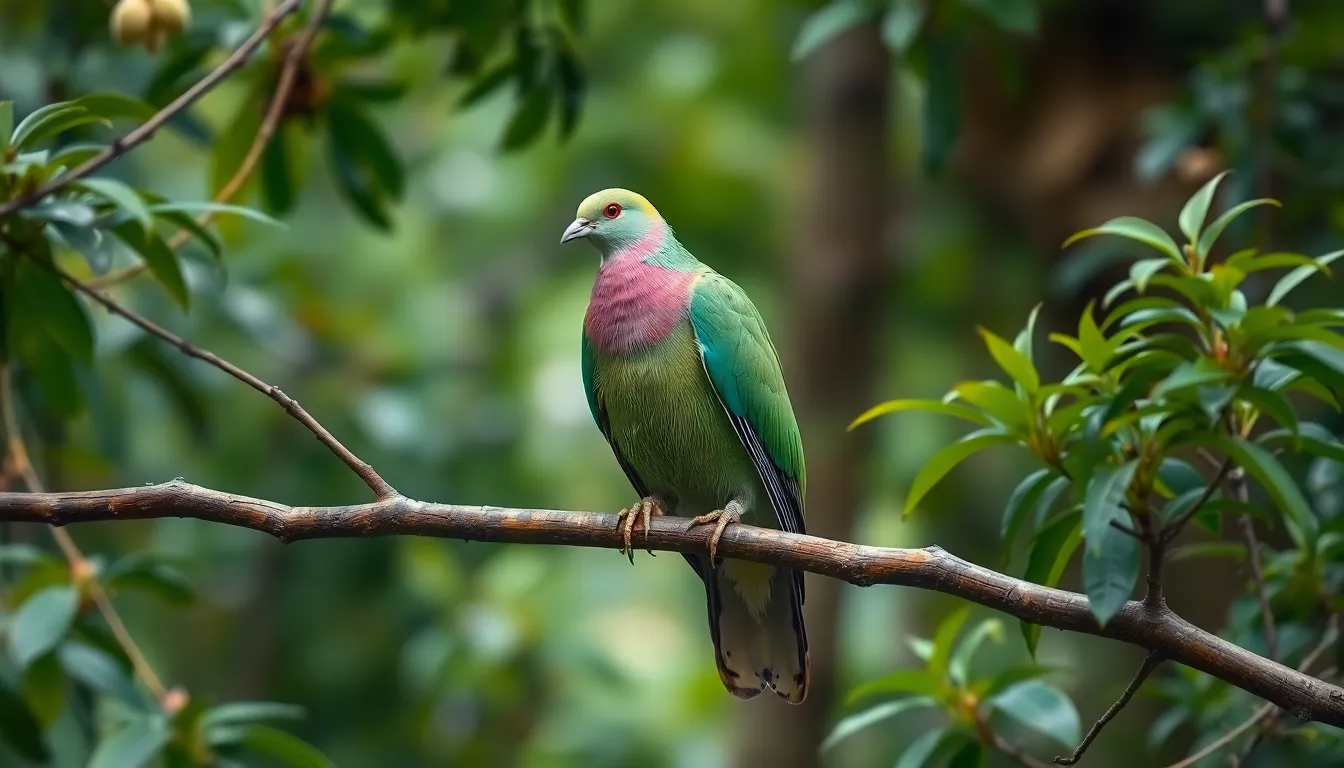
Most pigeon species maintain stable populations across their global distribution ranges, with conservation statuses varying significantly among the 340+ species in the Columbidae family. Urban pigeons thrive in metropolitan environments, but several specialized species face mounting pressures from habitat destruction and human activities.
Threatened Pigeon Species Face Critical Population Declines
| Species | Conservation Status | Population Estimate | Primary Threats |
|---|---|---|---|
| Pink-necked Green Pigeon | Near Threatened | 50,000-499,999 | Deforestation, hunting |
| Nicobar Pigeon | Near Threatened | 180,000 | Habitat loss, introduced predators |
| Mindoro Bleeding-heart | Vulnerable | 2,500-9,999 | Forest clearance, hunting |
| Negros Bleeding-heart | Critically Endangered | 50-249 | Deforestation, trapping |
| Socorro Dove | Extinct in Wild | 200 (captive) | Habitat destruction, predation |
Endemic island species demonstrate the highest vulnerability rates among pigeon populations. Forest-dwelling pigeons experience severe habitat fragmentation as logging operations and agricultural expansion reduce their nesting territories by 15-20% annually in tropical regions. Coastal species encounter additional pressures from sea-level rise and coastal development projects.
Habitat Loss Drives Primary Conservation Concerns
Agricultural conversion eliminates natural foraging grounds for ground-dwelling pigeon species across multiple continents. Urbanization fragments migration corridors, forcing pigeons to navigate increasingly complex landscapes between breeding and feeding sites. Climate change alters seed production cycles in native plant species, disrupting traditional food sources for specialized fruit and seed eating pigeons.
Disease Transmission and Population Health
Avian diseases including Newcastle disease and pigeon pox affect wild populations, particularly in areas with high population densities. Parasitic infections from mites and lice increase mortality rates among juvenile pigeons by 12-18% in affected colonies. Environmental pollutants accumulate in urban pigeon tissues, though long-term population impacts remain under scientific investigation.
Hunting Pressure and Human Exploitation
Traditional hunting practices target larger pigeon species for food in developing regions, with annual harvest rates exceeding sustainable reproduction levels for several species. Trapping for the pet trade removes breeding adults from wild populations, particularly affecting colorful species like the Nicobar pigeon and various fruit dove species. Commercial exploitation historically eliminated entire populations, as demonstrated by the Passenger Pigeon extinction in 1914.
Conservation Success Stories
Captive breeding programs successfully maintain genetic diversity for critically endangered species like the Socorro Dove. Protected area designations preserve critical breeding habitats for endemic species across island ecosystems. Community-based conservation initiatives engage local populations in monitoring and protection efforts, reducing hunting pressure on vulnerable species by 30-45% in participating regions.
Current Population Monitoring Efforts
Research teams conduct annual population surveys using standardized protocols across major pigeon habitats worldwide. Satellite tracking technology monitors migration patterns and habitat usage for threatened species. Genetic studies identify distinct subspecies requiring separate conservation strategies and management approaches.
Conclusion
Pigeons represent one of nature’s most successful evolutionary stories. We’ve witnessed their transformation from wild cliff-dwellers to urban pioneers who’ve mastered life alongside humans across six continents.
Their cognitive abilities continue to surprise researchers while their adaptability ensures their survival in our rapidly changing industry. From the bustling streets of major cities to remote tropical forests these remarkable birds demonstrate resilience that few species can match.
As we move forward it’s essential that we balance our coexistence with pigeons through thoughtful management strategies. We must also prioritize conservation efforts for threatened species before they follow the tragic path of the Passenger Pigeon.
These feathered companions deserve our respect and understanding as intelligent creatures who’ve shared our industry for millennia.
Frequently Asked Questions
How intelligent are pigeons compared to other birds?
Pigeons possess remarkable cognitive abilities that rival those of primates. They demonstrate advanced problem-solving skills, can recognize themselves in mirrors, learn complex tasks, and even assist in medical research by identifying cancerous tissue. Their intelligence includes sophisticated navigation systems using magnetoreceptors and exceptional memory capabilities that make them among the smartest bird species.
What makes pigeons so successful in urban environments?
Pigeons thrive in cities due to their exceptional adaptability and the resources urban environments provide. Cities offer abundant nesting sites in buildings, consistent food sources from human waste, and protective microclimates that extend breeding seasons. Urban pigeon populations can reach densities of 2,000 to 10,000 individuals per square kilometer, benefiting from year-round food availability and reduced predation.
How many pigeon species exist worldwide?
The Columbidae family includes over 340 pigeon species distributed across six continents and approximately 120 countries. These species vary dramatically in size, from the small diamond dove to the large Victoria crowned pigeon, and inhabit diverse environments ranging from urban areas to tropical rainforests, coastal cliffs, and desert regions.
What do pigeons typically eat?
Pigeons are omnivorous with remarkable dietary flexibility, primarily consuming seeds, grains, fruits, and plant materials. They occasionally supplement their diet with insects and small invertebrates. Their feeding habits include ground foraging and flocking strategies, while their crop organ allows for efficient food storage and digestion, contributing to their global success.
How fast do pigeons reproduce?
Pigeons have highly efficient breeding cycles, capable of reproducing multiple times per year, which contributes to rapid population growth. Both parents share incubation duties and feed their young through crop milk production. Their complex mating rituals include elaborate courtship displays and strong pair bonding behaviors that ensure successful reproduction throughout extended breeding seasons.
What was the historical significance of messenger pigeons?
Pigeons served as vital communication partners for over 5,000 years across various civilizations. Ancient Egyptians and Persians utilized them for message delivery, while medieval European kingdoms relied on their remarkable navigation abilities during critical periods. Their speed, accuracy, and ability to return home made them invaluable for long-distance communication before modern technology.
Are pigeons dangerous to human health?
Despite common concerns, disease transmission rates from pigeons to humans are extremely low. While pigeon droppings can cause property damage and create sanitation issues, actual health risks are minimal when proper precautions are taken. Most health concerns are overstated, and pigeons pose less risk than many other urban wildlife species.
Which pigeon species are currently threatened?
Several specialized pigeon species face conservation challenges, including the Pink-necked Green Pigeon and the Nicobar Pigeon. These species are primarily threatened by habitat destruction, climate change, and hunting pressures, particularly endemic island species. The extinct Passenger Pigeon serves as a cautionary tale about the vulnerability of wildlife populations to human exploitation.
How do pigeons navigate so accurately?
Pigeons possess sophisticated navigation systems utilizing multiple sensory mechanisms, including magnetoreceptors and cryptochromes in their eyes for detecting magnetic fields. These specialized anatomical features, combined with their ability to use visual landmarks and infrasound, allow them to navigate with remarkable accuracy over long distances and return to specific locations consistently.
What conservation efforts are helping protect pigeon species?
Current conservation initiatives include captive breeding programs, community-based projects that reduce hunting pressure, and population monitoring using advanced technology. Habitat modification strategies focus on protecting natural environments rather than eliminating pigeons, while research efforts track threatened species and implement protective measures for vulnerable populations worldwide.

